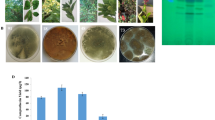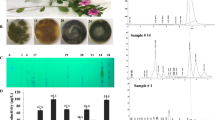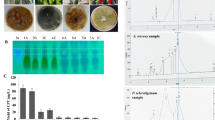Abstract
Camptothecin (CPT), the third largest anticancer drug, is produced mainly by Camptotheca acuminata and Nothapodytes foetida. CPT itself is the starting material for clinical CPT-type drugs, but the plant-derived CPT cannot support the heavy demand from the global market. Research efforts have been made to identify novel sources for CPT. In this study, three CPT-producing endophytic fungi, Aspergillus sp. LY341, Aspergillus sp. LY355, and Trichoderma atroviride LY357, were isolated and identified from C. acuminata. Most CPT produced by these fungi was found in the fermentation broth, and their corresponding CPT yields were 7.93, 42.92, and 197.82 μg l−1, respectively. The CPT-producing capability of LY341 and LY355 was completely lost after repeat subculturing. A substantial decrease of CPT production was also observed in the second generation of LY357. However, a stable and sustainable production of CPT was found from the second generation through the eighth generation of LY357. The fermentation medium, time, pH, temperature, and agitation rate were optimized for CPT production. Methyl jasmonate and XAD16 were proven to be an optimum elicitor and adsorbent resin, respectively, in view of that CPT yield was increased 3.4- and 11-fold through their use. A 50- to 75-fold increase of CPT yield was obtained when the optimized fermentation conditions, elicitor, and adsorbent resin were combined and applied to the culture of the seventh and eighth generations of LY357, and the highest CPT yield was 142.15 μg l−1. The CPT-producing T. atroviride LY357 paves a potential to uncover the mysteries of CPT biosynthesis.




Similar content being viewed by others
References
Aly AH, Debbab A, Kjer J, Proksch P (2010) Fungal endophytes from higher plants: a prolific source of phytochemicals and other bioactive natural products. Fungal Divers 41:1–16
Aly AH, Debbab A, Proksch P (2011) Fungal endophytes: unique plant inhabitants with great promises. Appl Microbiol Biotechnol 90:1829–1845
Amna T, Puri SC, Verma V, Sharma JP, Khajuria RK, Musarrat J, Spiteller M, Qazi GN (2006) Bioreactor studies on the endophytic fungus Entrophospora infrequens for the production of an anticancer alkaloid camptothecin. Can J Microbiol 52:189–196
Demain AL, Vaishnav P (2011) Natural products for cancer chemotherapy. Microbiol Biotechnol 4:687–699
Findlay JA, Buthelezi S, Li GQ, Seveck M (1997) Insect toxins from an endophytic fungus from wintergreen. J Nat Prod 60:1214–1215
Gunatilaka AAL (2006) Natural products from plant-associated microorganisms: distribution, structural diversity, bioactivity, and implications of their occurrence. J Nat Prod 69:509–526
Guo B, Wang Y, Sun X, Tang K (2008) Bioactive natural products from endophytes: a review. Appl Biochem Microbiol 44:136–142
Gurudatt PS, Priti V, Shweta S, Ramesha BT, Ravikanth G, Vasudeva R, Amna T, Deepika S, Ganeshaiah KN, Shaanker RU, Puri S, Qazi GN (2010) Attenuation of camptothecin production and negative relation between hyphal biomass and camptothecin content in endophytic fungal strains isolated from Nothapodytes nimmoniana Grahm (Icacinaceae). Curr Sci 98:1006–1010
Hsiang YH, Hertzberg R, Hecht S, Liu LF (1985) Camptothecin induces protein-linked DNA breaks via mammalian DNA topoisomerase I. J Biol Chem 260:14873–14878
Kharwar RN, Mishra A, Gond SK, Stierle A, Stierle D (2011) Anticancer compounds derived from fungal endophytes: their importance and future challenges. Nat Prod Rep 28:1208–1228
Kitajima M, Yoshida S, Yamagata K, Nakamura M, Takayama H, Saito K, Seki H, Aimi N (2002) Camptothecin-related alkaloids from hairy roots of Ophiorrhiza pumila. Tetrahedron 58:9169–9178
Kusari S, Spiteller M (2011) Are we ready for industrial production of bioactive plant secondary metabolites utilizing endophytes? Nat Prod Rep 28:1203–1207
Kusari S, Lamshöft M, Zühlke S, Spiteller M (2008) An endophytic fungus from Hypericum perforatum that produces hypericin. J Nat Prod 71:159–162
Kusari S, Zühlke S, Spiteller M (2009) An endophytic fungus from Camptotheca acuminata that produces camptothecin and analogues. J Nat Prod 72:2–7
Kusari S, Zühlke S, Spiteller M (2011) Effect of artificial reconstitution of the interaction between the plant Camptotheca acuminata and the fungal endophyte Fusarium solani on camptothecin biosynthesis. J Nat Prod 74:764–775
Kusari S, Hertweck C, Spiteller M (2012) Chemical ecology of endophytic fungi: origins of secondary metabolites. Chem Biol 19:792–798
Liu K, Ding X, Deng B, Chen W (2010) 10-Hydroxycamptothecin produced by a new endophytic Xylaria sp., M20, from Camptotheca acuminata. Biotehnol Lett 32:689–693
Liu B, Hui J, Cheng Y, Zhang X (2012) Extractive fermentation for enhanced production of thailandepsin A from Burkholderia thailandensis E264 using polyaromatic adsorbent resin diaion HP-20. J Ind Microbiol Biotechnol 39:767–776
Lorence A, Nessler CL (2004) Camptothecin, over four decades of surprising findings. Phytochemistry 65:2735–2749
Lorence A, Medina-Bolivar F, Nessler CL (2004) Camptothecin and 10-hydroxycamptothecin from Camptotheca acuminata hairy roots. Plant Cell Rep 22:437–441
Neuss N, Gorman M, Boaz HE, Cone NJ (1962) Vinca alkaloids. XI. Structures of leurocristine (LCR) and vincaleukoblastine (VLB). J Am Chem Soc 84:1509–1510
Parawira W, Tekere M (2011) Biotechnological strategies to overcome inhibitors in lignocellulose hydrolysates for ethanol production: review. Crit Rev Biotechnol 31:20–31
Puri SC, Verma V, Amna T, Qazi GN, Spiteller M (2005) An endophytic fungus from Nothapodytes foetida that produces camptothecin. J Nat Prod 68:1717–1719
Puri SC, Nazir A, Chawla R, Arora R, Riyaz-ul-Hasan S, Amna T, Ahmed B, Verma V, Singh S, Sagar R, Sharma A, Kumar R, Sharma RK, Qazi GN (2006) The endophytic fungus Trametes hirsuta as a novel alternative source of podophyllotoxin and related aryl tetralin lignans. J Biotechnol 122:494–510
Qin S, Xing K, Jiang JH, Xu LH, Li WJ (2011) Biodiversity, bioactive natural products and biotechnological potential of plant-associated endophytic actinobacteria. Appl Microbiol Biotechnol 89:457–473
Rehman S, Shawl AS, Kour A, Andrabi R, Sudan P, Sultan P, Verma V, Qazi GN (2008) An endophytic Neurospora sp. from Nothapodytes foetida producing camptothecin. Appl Biochem Microbiol 44:203–209
Rehman S, Shawl AS, Kour A, Sultan P, Ahmad K, Khajuria R, Qazi GN (2009) Comparative studies and identification of camptothecin produced by an endophyte at shake flask and bioreactor. Nat Prod Res 23:1050–1057
Shaanker RU, Ramesha BT, Ravikanth G, Gunaga R, Vasudeva R, Ganeshaiah KN (2008) Chemical profiling of Nothapodytes nimmoniana for camptothecin, an important anticancer alkaloid: towards the development of a sustainable production system. In: Ramawat KG, Mérillon JM (eds) Bioactive molecules and medicinal plants. Springer, Berlin, pp 197–213
Shen SH, Liu JY, Hu JQ, Li XH, Wang LL (2011) Advances in studies on biosynthetic pathways of camptothecin and their synthase. Chin Trad Herbal Drugs 42:1862–1868
Shweta S, Züehlke S, Ramesha BT, Priti V, Kumar PM, Ravikanth G, Spiteller M, Vasudeva R, Shaanker RU (2010) Endophytic fungal strains of Fusarium solani, from Apodytes dimidiata E. Mey. ex Arn (Icacinaceae) produce camptothecin, 10-hydroxycamptothecin and 9-methoxycamptothecin. Phytochemistry 71:117–122
Shweta S, Gurumurthy BR, Ravikanth G, Ramanan US, Shivanna MB (2013) Endophytic fungi from Miquelia dentata Bedd., produce the anti-cancer alkaloid, camptothecine. Phytomedicine 20:337–342
Singh MP, Leighton MM, Barbieri LR, Roll DM, Urbance SE, Hoshan L, McDonald LA (2010) Fermentative production of self-toxic fungal secondary metabolites. J Ind Microbiol Biotechnol 37:335–340
Sirikantaramas S, Asano T, Sudo H, Yamazaki M, Saito K (2007) Camptothecin: therapeutic potential and biotechnology. Curr Pharm Biotechnol 8:196–202
Stierle A, Strobel G, Stierle D (1993) Taxol and taxane production by Taxomyces andreanae, an endophytic fungus of Pacific yew. Science 260:214–216
Stierle A, Strobel G, Stierle D, Grothaus P, Bignami G (1995) The search for a taxol-producing microorganism among the endophytic fungi of the Pacific yew, Taxus brevifolia. J Nat Prod 58:1315–1324
Thomas CJ, Rahier NJ, Hecht SM (2004) Camptothecin: current perspectives. Bioorg Med Chem 12:1585–1604
Wall ME, Wani MC, Cook CE, Palmer KH, McPhail AT, Sim GA (1966) Plant antitumor agents. I. The isolation and structure of camptothecin, a novel alkaloidal leukemia and tumor inhibitor from Camptotheca acuminata. J Am Chem Soc 88:3887–3890
Wani MC, Taylor HL, Wall ME, Coggon P, McPhail AT (1971) Plant antitumor agents. VI. Isolation and structure of taxol, a novel antileukemic and antitumor agent from Taxus brevifolia. J Am Chem Soc 93:2325–2327
Acknowledgments
The authors wish to thank Ms. Tao Yang for morphological characterization and to acknowledge the financial support in part by the forefront program, the “Western Light” joint project, and the Science and Technology Project for Outstanding Youths in Life Science (KSCX2-EW-Q-6) from the Chinese Academy of Sciences and the project (21172216) from the National Natural Science Foundation of China.
Author information
Authors and Affiliations
Corresponding authors
Rights and permissions
About this article
Cite this article
Pu, X., Qu, X., Chen, F. et al. Camptothecin-producing endophytic fungus Trichoderma atroviride LY357: isolation, identification, and fermentation conditions optimization for camptothecin production. Appl Microbiol Biotechnol 97, 9365–9375 (2013). https://doi.org/10.1007/s00253-013-5163-8
Received:
Revised:
Accepted:
Published:
Issue Date:
DOI: https://doi.org/10.1007/s00253-013-5163-8




